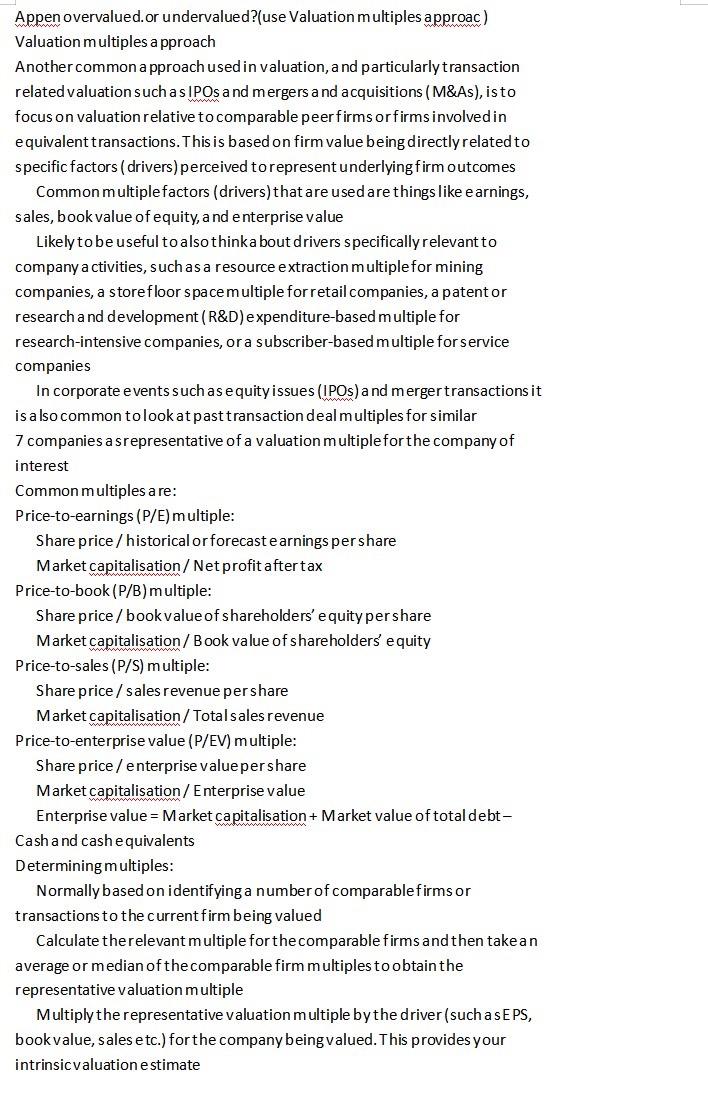
Appen overvalued.or undervalued?(use Valuation multiples approac) Valuation multiples approach Another common approach used in valuation, and particularly transaction related valuation such as IPOs and mergers and acquisitions (M&As), isto focus on valuation relative to comparable peer firms or firms involved in equivalent transactions. This is based on firm value being directly related to specific factors (drivers)perceived torepresent underlying firm outcomes Common multiple factors (drivers) that are used are things like earnings, sales, book value of equity, and enterprise value Likely to be useful to also thinkabout drivers specifically relevant to company activities, such as a resource extraction multiple for mining companies, a storefloor space multiple for retail companies, a patentor research and development (R&D) expenditure-based multiple for research-intensive companies, or a subscriber-based multiple for service companies In corporate events such as equity issues (IPOs) a nd mergertransactions it is also common tolook at past transaction deal multiples for similar 7 companies asrepresentative of a valuation multiple for the company of interest Common multiples are: Price-to-earnings (P/E) multiple: Share price / historical or forecast earnings per share Market capitalisation / Net profit after tax Price-to-book (P/B) multiple: Share price / book value of shareholders' e quity per share Market capitalisation / Book value of shareholders' equity Price-to-sales (P/S) multiple: Share price / sales revenue per share Market capitalisation / Total sales revenue Price-to-enterprise value (P/EV) multiple: Share price / enterprise value per share Market capitalisation / Enterprise value Enterprise value = Market capitalisation + Market value of total debt- Cash and cash equivalents Determining multiples: Normally based on identifying a number of comparablefirms or transactions to the current firm being valued Calculate the relevant multiple for the comparable firms and then takean average or median of the comparable firm multiples to obtain the representative valuation multiple Multiply the representative valuation multiple by the driver (such as EPS, book value, sales etc.) for the company being valued. This provides your intrinsicvaluation estimate Appen overvalued.or undervalued?(use Valuation multiples approac) Valuation multiples approach Another common approach used in valuation, and particularly transaction related valuation such as IPOs and mergers and acquisitions (M&As), isto focus on valuation relative to comparable peer firms or firms involved in equivalent transactions. This is based on firm value being directly related to specific factors (drivers)perceived torepresent underlying firm outcomes Common multiple factors (drivers) that are used are things like earnings, sales, book value of equity, and enterprise value Likely to be useful to also thinkabout drivers specifically relevant to company activities, such as a resource extraction multiple for mining companies, a storefloor space multiple for retail companies, a patentor research and development (R&D) expenditure-based multiple for research-intensive companies, or a subscriber-based multiple for service companies In corporate events such as equity issues (IPOs) a nd mergertransactions it is also common tolook at past transaction deal multiples for similar 7 companies asrepresentative of a valuation multiple for the company of interest Common multiples are: Price-to-earnings (P/E) multiple: Share price / historical or forecast earnings per share Market capitalisation / Net profit after tax Price-to-book (P/B) multiple: Share price / book value of shareholders' e quity per share Market capitalisation / Book value of shareholders' equity Price-to-sales (P/S) multiple: Share price / sales revenue per share Market capitalisation / Total sales revenue Price-to-enterprise value (P/EV) multiple: Share price / enterprise value per share Market capitalisation / Enterprise value Enterprise value = Market capitalisation + Market value of total debt- Cash and cash equivalents Determining multiples: Normally based on identifying a number of comparablefirms or transactions to the current firm being valued Calculate the relevant multiple for the comparable firms and then takean average or median of the comparable firm multiples to obtain the representative valuation multiple Multiply the representative valuation multiple by the driver (such as EPS, book value, sales etc.) for the company being valued. This provides your intrinsicvaluation estimate







